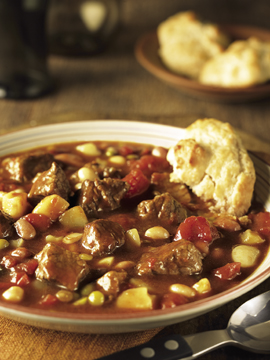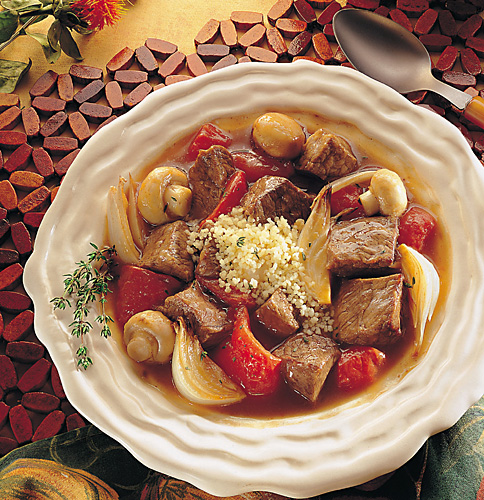With the holidays over, every night can’t be a perfect Porterhouse or fabulous filet. The pendulum, however, doesn’t have to swing completely from awesome to austere. You don’t have to sacrifice peak dining just because you’re being frugal about what you put on the table.
So how do you reconcile the desire for exceptional eating experiences any day of the week with an equal desire to be more economical in the kitchen?
Cooking in quantity is one solution. Stewing, like braising and soup-making is a moist-heat method of cooking large quantities of meat and/or vegetables in liquid for an extended period of time. Unlike some dishes, stews freeze very well, so there’s no such thing as making too much stew. Doubling, tripling, or quadrupling a recipe does not require that much more effort.
And, if you always start with the best ingredients, you’ll never want for better flavor or soul-satisfying results. You won’t believe the difference that using the very finest and freshest meats makes in your soon-to-be slow-cooked classics. Old hands will be amazed at how Lobel’s meats add new dimensions of flavor and tenderness to your favorite recipes.
Economic in terms of cost and time, stews are all about assembly, the passage of time, and patience. Stew doesn’t require a lot of utensils, nor do you have to hover and fuss over it.
It’s a great dish to have slowly bubbling on the stove over a Saturday or Sunday while you engage in other at-home pursuits. The wafting aromas filling the house are a Siren’s song to those nearby not to stray: Dinnertime with the family is fast approaching.
On the other hand, stew is a great anytime dish to have on hand for mealtime stragglers who need a bowl on the run or for freezing in portions for heat-and-serve convenience. It’s also a favorite meaty, manly dish for armchair quarterbacks to enjoy during the big game.
Using a Slow Cooker
Making stew in a slow cooker is ideal for those with hectic weekday schedules. Pull everything together, go to work, and come home to a wonderland of comfort food.
It’s important to remember that when you use a slow cooker, you end up with more liquid in the pot than what you had at the start. That’s because the seal on the slow-cooker lid is so tight, no moisture escapes, and the condensation from the moist heat drips back into what’s being cooked. That means the stew liquid will have a somewhat thin flavor.
So, if you are a stickler for intense flavors, you can always take the stew from the slow cooker and finish cooking in a Dutch oven or heavy stockpot on the stove with the lid off to reduce the liquid and concentrate the flavor.
Alternatively, you can add a few ounces of glace or demi-glace to fortify the flavor.
Render Tender
Naturally, tender premium cuts come at a price. Stewing, on the other hand, uses less expensive and less tender cuts—working muscles—that are rendered tender through long, moist cooking.
Lobel’s online butcher shop features pre-cut Family-Cut Favorites stewing cubes of USDA and Natural Prime Beef, Berkshire Pork, and All-Natural Lamb and Veal.
Stewing is among the oldest cooking techniques and can be found around the world in every culture. You can take an exciting trip around the globe without leaving home by trying out recipes from the classic French boeuf bourguignon and sambar from India to barbacoa from Mexico and tagines from Morocco.
Stewing Variations
Shepard’s Pie – Traditionally lamb is the meat of choice. But you can put any kind of stew in a baking dish, top it with mashed potatoes, and bake so the potatoes take on highlights of a crusty brown top layer. If you want to get fancy, put the mashed potatoes in a pastry bag fitted with a large star tip and pipe the potatoes onto the stew in a decorative motif.
Dumplings – Simple flour dumplings are another delicious topping for stew. Baked with the stew, dumplings transform from doughy nuggets to become crusty islands, fluffy on the inside and ready to soak up every drop of luscious stewing juices. Take dumplings one step farther and season them according to the seasonings in the stew—thyme with beef, for example, rosemary and garlic with lamb, or sage with poultry.
Pot pie – Forget the pallid little store-bought pies encased in aluminum. Take your favorite stew, put it between two layers of homemade short-crust pastry, and bake to a golden brown.
Pumpkin – You’re probably familiar with soup or stew in bread bowl. How about stew in a pumpkin? Essentially, you cook any type of stew for 2 to 3 hours and then put the stew in a cleaned-out pumpkin and bake for a couple of hours more. To serve, ladle out the stew and scrape some of the pumpkin into each serving.
How To: Stew
For a range of stewing dishes, the Lobel family’s books Lobel’s Prime Cuts, Lobel’s Meat and Wine, and the new Lobel’s Meat Bible have plenty of recipes, tips, and techniques to keep you inspired for a long time to come.
For a tutorial on the master technique of creating a stew, check out our YouTube video:



Leave Your Response